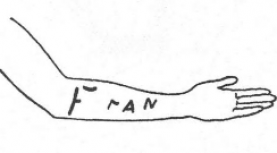
Olga Kahl was a Russian woman with psychic abilities, of which the most striking was to cause words and images that she received telepathically from other people to appear briefly as red marks on her skin. She was the subject of several reports by European researchers, mostly published around 1930.
Background
Little is known about Olga Kahl’s origin. She was Russian by extraction,1 married a Turkish man whose surname was Toukholka, worked as a professional medium, and lived in Paris during the 1920s when her abilities were investigated.
As a child Olga reportedly appeared sometimes to know other people’s thoughts. She also appeared to have access to a source of knowledge, which her mother took advantage of, subjecting her to hypnosis in order to get answers to practical questions. Olga helped with her parents’ gold-prospecting business, map-dowsing for the areas in Siberia with the richest ores.2
Aged nineteen, she started to manifest a new phenomenon. When she became anxious at the discovery that she had lost a string of pearls, several round reddened areas appeared on the skin of her arms. Later incidents confirmed that the effect could be stress-related. When a fish bone became stuck in her throat, a red area in the shape of a fish bone appeared on her neck; on another occasion, having watched dervishes thrusting skewers through their cheeks she developed an abscess on one of hers.3
When she was twenty, a friend told her about Indian fakirs who could make representations of their thoughts appear on their skin, and suggested she try to do the same. The friend gave her an envelope that concealed a small plant; after she had felt it a red area in the shape of a clover leaf appeared on one of her forearms.4
Investigations
Toukholka
The first report about Kahl her was published by her husband Toukholka as a letter to the journal Revue Métapsychique.5 Toukholka wrote that he had carried out experiments with Kahl that produced evidence for a variety of psychic phenomena.6
First he wrote a name or phrase on paper, keeping it out of her view, and after a minute or so she wrote it correctly, even if he used a language she did not know.
After marking a series of playing cards with letters of the alphabet, Toukholka silently chose a word and handed Kahl the deck, upon which she would choose the cards whose letters made up his word.
Toulholka was given a sealed envelope containing a photograph, which he knew only was of a woman. He placed the envelope on Kahl’s head. Kahl described the photographed woman accurately, including the image on her brooch. She performed a similar feat with a letter, accurately discerning the situation it described.
In professional readings, Kahl was often able to answer a question written by the client on a piece of paper but not shown to her. She answered by automatic writing (writing in a dissociated state), usually accurately.
Besides telepathy she displayed clairvoyance, correctly naming objects held by people in another room. She also displayed precognition, on one occasion correctly predicting that a client planning to travel would be delayed by unexpected circumstances. On 19 April 1916, she had a vision of a Russian ship sinking and its men drowning; when asked to try to identify the name of the ship by automatic writing she produced the word ‘Mercur’. One month later the Russian ship Mercurii sank with the loss of many lives.
Toukholka also recounted a skin-writing experiment; after a visiting doctor asked Kahl to guess the name of his mother, which was ‘Lubov’, the letters L, U, B and an indistinct ending appeared on her arm, fading after one or two minutes.
Eugene Osty
Eugène Osty, director of the Institute Métapsychique International, was the first scientist to investigate Kahl’s abilities.7 He started in October 1927, first determining she had the common psychic gift of discerning details of a person’s character and life psychically, then that she could detect a name, word, number, drawing or even whole phrase thought by someone else, whether written down or held as a mental image. Finding it impractical in the conditions of the experiment to photograph the skin-writing he instead created illustrations (below).
Osty first tested the ‘skin-writing’ in the presence of some ten medical professionals.8 At the first sitting, Kahl asked Osty to hold her left wrist while he thought of a word. He chose ‘Rosa’. After fifteen seconds, she rubbed her left forearm, and a large capital ‘R’ appeared, followed by a small ‘o’. Unable to manage more, Kahl said ‘You were thinking of a rose.’ The letters disappeared after about a minute.

Fig 19
In a second experiment some nine weeks later, Osty prepared twenty slips of paper with drawings of simple designs, chose one randomly (an incomplete triangle) and gazed at it for two seconds, then put it back in with the others and pressed them against Kahl’s forehead. Two lines forming an angle appeared on her forearm; making a drawing, she added the two lines extending toward each other, but left off the upright hooks that were on the original (a and b).
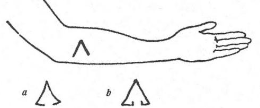
Fig 2
Three weeks later, a Dr d’Espinay and three other people helped with the experiment. D’Espinay was asked to think of a word, and letters showed up faintly on Kahl’s forearm; when a woman present rubbed the spot the letters clearly showed up as ‘F r a n’. The doctor revealed that the word he had thought of was the name François.

Fig 3
Kahl asked another woman present, Mrs S, to hold one of her hands and think of a word. The letter ‘Y’ appeared on Kahl’s forearm. ‘Is it “Yvonne” you were thinking?’, Kahl asked, but Mrs S did not answer. More letters came up producing, in total, ‘Y l a n d e’, with a space between the ‘Y’ and the ‘l’, and Mrs S revealed she had been thinking of the name ‘Yolande’.

Fig 4
Mrs S was asked to think of something again, this time choosing the numeral ‘8’. An elongated ‘x’ appeared on her forearm (A). Kahl was then told the target number was an ‘8’, after which a curve appeared on the cross (B); however, she was unable to complete the second curve.
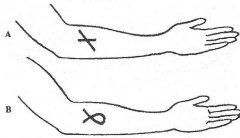
Fig 5
Kahl’s arms having become flushed, she suggested using her upper chest as a display surface. Osty imagined a horizontal line crossed by two slanting parallel lines. The horizontal line appeared immediately, about six centimetres long, followed by two lines crossing, though not quite parallel.
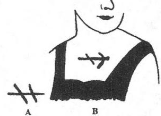
Fig 6
Charles Richet, a leading psychical researcher, was present at a session held a week later where lettered cards were used. A doctor was asked to pick a card randomly and then think of a name that started with the letter it indicated; he chose ‘René’. The letters ‘R E H’ appeared on Kahl’s arm (it was hypothesized that the ‘H’ was in fact the Cyrillic letter for ‘N’, being more familiar to Kahl).

Fig 7
Next, Richet made a drawing of a triangle with two lines inside it (B). An angle appeared on Kahl’s arm (A) which then was completed as a triangle (C) when she saw Richet’s drawing. Despite strong efforts she could not produce the other two lines.
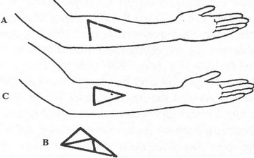
Fig 8
The name ‘Sabine’ was written by a person outside the room on a piece of paper that was then folded and hidden. Kahl managed to produce a cursive ‘S’ along with ‘A B N’ and a line.

Fig 9
At a final session five weeks later, Kahl produced a simple skin-image of a wine glass she had briefly looked at, and accurately guessed three of the names of a person present.10
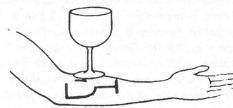
Fig 10
By Osty’s count, his 73 experiments with Kahl resulted in 36 full successes and 15 partial successes, a 70% success rate. He stated that Kahl was the only person he’d ever seen in 22 years of research who could predictably detect pure thoughts in the minds of other people.11
Theodore Besterman
Researchers Theodore Besterman and René Warcollier met with Kahl on 10 October 1928 for the first of three sittings, during which many figures appeared on the skin of her arms. Besterman’s illustrated report appeared in the Proceedings of the Society for Psychical Research.12 As usual with Kahl, there were some complete successes, some partial successes and some failures.
A curious incident occurred when she was trying to guess the name of Warcollier’s wife Germaine, when she seemed to draw telepathically from both researchers. She correctly chose the first letter ‘G’, but then said ‘Genriette’ (Besterman’s wife was named Henriette).
These sessions involved the kind of questions asked by a medium’s clients, which had been written on cards. She was adept at guessing both questions and answers; for instance, when Besterman wordlessly picked the card that said ‘Will I marry?’, Kahl promptly stated that the question was not serious as he was already married, which was correct.
Besterman tried to estimate the odds of the successes happening by pure chance. For the first sitting, he arrived at 1:100,000, for the second 1:1,200 and for the third, 1:1.2 million.
David Efron
David Efron, an Argentinian researcher with degrees in philosophy and sociology, investigated Kahl in August 1929.13 In the first attempt, he picked a card and from the letter it indicated mentally constructed the name ‘René’. Kahl, from a separate room, suddenly shouted ‘That’s it! You have thought of the name René!’ However, he considered this might be due to chance, since René is a common name.
Efron was also disconcerted by her ‘theatrical’ behaviour:
Her excitement appeared to have increased, and her face was somewhat flushed. She did not seem to be able to keep quiet for a single moment. She sat down on the sofa, got up at once as if moved by an invisible spring, picked up an object, fiddled around with it for a while, laid it to rest, picked it up again, etc. ‘Everything will go well’, she repeated several times as if talking to herself. ‘I feel that I am well disposed now.’ I scrutinized each of her movements. She was moving around like a squirrel.
Osty had warned him of certain ‘circus preliminaries’ she demanded at the beginning of sessions, advising him ‘not to reject them entirely, for, in his opinion, they were the expression of an autosuggestive habit deeply rooted in the mind of the percipient’. Efron, having drawn the letter ‘S’ on a piece of paper, out of her presence, was suspicious when she asked to touch the hand in which he held it.
Opening up my fist a little, I allowed her to skim lightly the surface of the folded paper with her fingertips. She thanked me and suggested that I put it away now in one of my pockets. After that she asked me to let her touch my empty hand for a moment. Then she uncovered her left arm. Getting hold of my empty hand with her left one, she then started rubbing part of her bare left forearm with her free hand and asked me to concentrate mentally on the message. Although the rubbing technique seemed to me highly suspicious, I yielded once more to her request, not without making sure with my free hand that the paper was still in my pocket. After about twenty seconds a blurred, reddish sign appeared on her forearm and rapidly acquired the shape or outline of an oblique S.
The letter was perfectly visible for about half a minute and then faded away as quickly as it had come up, disappearing finally into a diffused spot of the same color.
Efron tried to erase the image, but without success; it remained ‘for about half a minute and then faded away as quickly as it had come up, disappearing finally into a diffused spot of the same color.’ He continues:
In spite of the inadequate experimental conditions under which the result had taken place, it was difficult for me to think that I had been the victim of a fraud, that the subject had managed to elude my vigilant watch and to outline, by a dishonest method, on her skin the sign I had chosen. But even granting that her technique had been swifter than my glance, there still remained a factor which appeared to speak in her favor: namely, in order to outline the sign mechanically it was necessary for her to know what the sign was, and I am absolutely certain that the paper had never been removed from my pocket, that during her brief contact with it Mme. Kahl could not have performed any legerdemain, and that at the time I had written on it nobody was with me in the other room. The hypothesis of some invisible mirror trick strikes me as extremely far-fetched because, as has already been pointed out, I made the drawing under the protection of my coat.14
In similar experiments images appeared on her arm corresponding to the those he had earlier drawn: a Star of David, a backwards question-mark and ‘Heri’ for the name ‘Henri’.
Still unsatisfied, Efron covertly disobeyed her instruction to commit the target image to paper, and an image he had merely imagined – two parallel lines linked by a circle – partly appeared on her chest. When he challenged her to repeat the feat, ‘an intensely red form appeared on her chest as if it had been projected from the inside of her thorax by an invisible cinematographic machine. It was strikingly similar to the image I had constructed mentally, a rectangle with its diagonals’.15
IC Grondahl
Some successful outcomes are given in a further account of a sitting with Kahl published in 1930 by IC Grondahl.16
Process
According to Osty, Kahl described her telepathic impressions coming mostly not as audible words but as visual images. She used automatic writing (‘écriture impulsive’) or drawing to prompt expression of the detected thought; when successful, a visual image would break through. The same might happen as figures appeared on her skin.
Barrington notes that drawn targets produced no more accurate responses than those that were purely imagined.17
Stevenson notes that predictions by both Osty and Besterman that a purely physiological explanation involving a pathway through the nervous system will eventually be discovered, have yet to be fulfilled. In his own analysis, he sees a three-step process in which the information was first somehow communicated to Kahl’s subconscious mind, then worked its way toward expression (sometimes modified by other contents of her mind), and finally became represented as red lines on her skin.
Concerning Kahl’s tendency to produce only the beginnings of words or figures, Stevenson notes that mistakes at the second level were to be expected, as these happen even in normal thought-expression processes, referred to by psychologists as ‘tip of the tongue’ syndrome.18
Stevenson observes that Kahl had no control over whether or not a figure would appear on her skin, nor how long it would take for the diffuse redness afterwards to fade (she sometimes found it necessary to seclude herself for a day or two after a session). However, she did have some control over where it was to appear: which forearm or which other part of her body. He points out that Osty had demonstrated, by means of applying a blunt instrument to her skin, that it was unusually insensitive to normal stimulation.19
Other Cases
Stevenson provides sources for four other people who have been recorded displaying paranormal skin-writing (though none but Olga Kahl is known to have combined it with telepathy.)20 He writes:
Other persons have claimed the ability to reproduce words on the skin from thoughts alone, without normal stimulation of the skin. Of these, the most notable is Soeur Jeanne des Anges, who was the principal possedee among the nuns of Loudun in the early 17th century (Jeanne des Anges, 1886). Her dermographism occurred on her hand. A critical eyewitness, Killigrew, stated:
...on her hand I saw a colour rise a little ruddy, and run for the length of an inch upon her vein, and in that a great many red specks; and they contracted into letters which made a distinct word; and it was the same she spake, “Joseph.”... This, as I live, I saw; nor could I find the least argument to question the reality of this miracle. (Killigrew, 1803, p. 10). (Joseph was the saint invoked to help free Soeur Jeanne from the devil possessing her; and Soeur Jeanne had spoken his name just before the name appeared on her hand.)
Other subjects showing paranormal dermographism include the three persons on whom Dr. M. H. Biggs induced with suggestion during hypnotism areas of erythema in the form of a cross (Gurney, 1887). In one subject part of the letter S appeared above the cross in response to an instruction to manifest the full word Sanctis at that site. Dr. Biggs gave verbal suggestions to two of the subjects, but with the third he expressed the wish for the cross to appear only to himself, that is, silently.21
Criticism
Commenting on a review by Besterman for the Journal of the Society for Psychical Research, WW Carington (then writing under the name Smith), presented concerns about Kahl’s behaviour and the conditions she imposed, which he considered unscientific and suggestive of trickery. He writes: ‘Although it would be too much to conclude that all the phenomena observed are tricks, we should be chary in attributing them to any other cause pending much more detailed evidence backed by the observations of a competent magician.’22
Stevenson notes that Carington made no mention of Osty’s investigation, adding that he himself considered the experimental controls used by both Besterman and Osty to be satisfactory.23
Besterman himself, similar to Efron, displayed a markedly sceptical tone in describing the experiments, but likewise appeared doubtful that trickery was the explanation.
KM Wehrstein
Literature
Barrington, M.R. (1996a). Archives: The Polish medium Olga Kahl. Psi Researcher 20 (February), 9-10.
Barrington, M.R. (1996b). Archives: Olga Kahl – Report by Eugene Osty. Psi Researcher 22 (August), 12-14.
Barrington, M.R. (2013). Archive No. 86: Ideas expressed as skin writing by Dr. Osty. Paranormal Review 66 (April), 9-12.
Besterman, T. (1929). Report of a four months’ tour of psychical investigation. Proceedings of the Society for Psychical Research 38, 409-72. [Section on Olga Kahl: 413-33.]
Besterman, T. (1930). Some Modern Mediums. London: Methuen.
Carington [Smith], W.W. (1930). Review of Some Modern Mediums, by T. Besterman. Journal of the Society for Psychical Research 26, 122-25.
Efron, D. (1944). Telepathic skin-writing (the Kahl case). Journal of Parapsychology 8, 272-86.
Grondahl, I.C. (1930). A sitting with Mme. Kahl. Journal of the Society for Psychical Research 26, 43-45.
Osty, E. (1929). Ce que la médecine doit attendre de 1’étude expérimentale des propriétés psychiques paranormales de l’homme. Revue métapsychique 79-148.
Osty, E. (1932.) Télépathie spontanée et transmission de pensée expérimentale. Revue Métapsychique, 233-56.
Stevenson, I. (1997). Reincarnation and Biology: A Contribution to the Etiology of Birthmarks and Birth Defects. Vol. I. Westport, Connecticut, USA: Praeger.
Toukholka, S. (1922.) Expériences de clairvoyance avec Mme. Olga Kahl. Revue métapsychique, 429-33.
Endnotes
- 1. Barrington (2013), 11. An earlier article by Barrington erroneously described her as Polish. Barrington (1996a).
- 2. Barrington (1996a), 10.
- 3. Stevenson (1997), 95.
- 4. Stevenson (1997), 95.
- 5. Toukholka (1922).
- 6. Barrington (1996a), 9. All information in this section is drawn from this English-language summary of Toukholka’s letter.
- 7. See Osty (1929, 1932).
- 8. Barrington (2013), 10. All information in this section is drawn from this source except where otherwise noted.
- 9. All figures are illustrations in Osty (1929), reproduced by Stevenson (1997), 97, 98, 101.
- 10. Barrington (1996b), 14.
- 11. Stevenson (1997), 94.
- 12. Besterman (1929). All information in this section is drawn from this source.
- 13. Efron (1944). All information in this section is drawn from this source.
- 14. Efron (1944), 278-9.
- 15. Efron (1944), 284.
- 16. Grondahl (1930).
- 17. Barrington (2013), 12.
- 18. Stevenson (1997), 97-8.
- 19. Stevenson (1997), 102.
- 20. Stevenson (1997), 103-4, n5.
- 21. See Stevenson (1997), 103-4, n5, for sources
- 22. Carington (1930), 124.
- 23. Stevenson (1997), 96.

